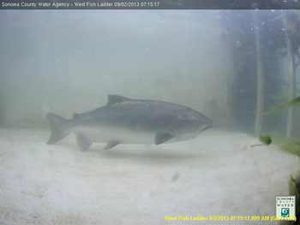About Dry Creek:
From its outlet in Warm Springs Dam, Dry Creek meanders 14 miles to the Russian River. The creek is home to endangered coho salmon and threatened Chinook salmon and steelhead (including steelhead raised at the Don Clausen Fish Hatchery). The creek also serves as a conduit for water that is released from Lake Sonoma by the U.S. Army Corps of Engineers in the winter for flood control purposes and by Sonoma Water in the summer for water supply.
Dry Creek Habitat Restoration Project
 The Dry Creek Habitat Restoration Project provides a unique opportunity for Sonoma Water and landowners to enhance habitat for endangered fish species in the Russian River watershed while continuing to deliver water to approximately 600,000 customers. The National Marine Fisheries Service and California Department of Fish & Wildlife biologists have determined that excessive water velocities and lack of suitable rearing habitat in Dry Creek threaten the recovery of endangered Coho and Steelhead.
The Dry Creek Habitat Restoration Project provides a unique opportunity for Sonoma Water and landowners to enhance habitat for endangered fish species in the Russian River watershed while continuing to deliver water to approximately 600,000 customers. The National Marine Fisheries Service and California Department of Fish & Wildlife biologists have determined that excessive water velocities and lack of suitable rearing habitat in Dry Creek threaten the recovery of endangered Coho and Steelhead.
The Habitat Restoration Project is creating habitat features that provide low-velocity areas for juvenile Coho and Steelhead along six miles of the 14-mile length of Dry Creek, while still allowing Sonoma Water to use Dry Creek as a means of moving water downstream for water supply purposes. The first mile of the project, known as the Demonstration Project, was completed in 2014 near Lambert Bridge.
Working with willing landowners, five additional miles of habitat restoration will be constructed by 2020. Sonoma Water and its contractors are currently designing and constructing miles 2 & 3 of the project, and conducting preliminary design for miles 4-6 of habitat restoration. The continued cooperation of property owners and the support of the community are key to the success of this program.
Learn more about the Dry Creek Habitat Restoration Project
Fisheries Studies & Monitoring
To determine whether and how habitat restoration is helping coho and steelhead, Sonoma Water Fisheries Biologists measure and monitor fish at several locations in Dry Creek during different times of the year. Techniques include large rotary screw traps (which safely capture fish and are checked daily), snorkeling surveys, and electrofishing.
Dry Creek Studies:
The Russian River Biological Opinion found that summer flows in the upper Russian River and Dry Creek are too high for optimal juvenile coho salmon and steelhead habitat. Current summer flows in the creek range from 110 to 175 cubic feet per second (cfs), which makes it difficult for the young fish to thrive. The Biological Opinion recognizes that large reductions in the summertime flows in Dry Creek would limit Sonoma Water's ability to deliver water to its customers. Therefore, the Biological Opinion requires habitat restoration of six miles of Dry Creek to improve summer rearing conditions for coho salmon and steelhead while allowing Sonoma Water to maintain the existing flow range in Dry Creek of 110 to 175 cfs.
The Fish Habitat Enhancement Feasibility study found that there are 45 opportunities for habitat restoration in Dry Creek. Learn more about the Dry Creek Habitat Restoration Project
A second study was released in April 2011. The Biological Opinion requires that Sonoma Water study the feasibility of building a pipeline to bypass Dry Creek in the unlikely event that habitat restoration is unsuccessful. The “Plan B” study, "Feasibility Study for Dry Creek Bypass Pipeline Project" analyzed options for getting water from Lake Sonoma into a pipeline (the inlet); potential routes (the alignment); and putting water from the pipeline into the Russia River or Dry Creek (the outlet).
An overview of the two studies and the studies themselves can be viewed at:
- Overview of Draft Habitat Enhancement & Draft Pipeline Feasibility Studies (PDF)
- Habitat Enhancement Study, April 2011 (PDF)
- Habitat Enhancement Presentation, May 2011 (PDF)
- Habitat Enhancement Conceptual Design Report, July 2012 (PDF)
- Pipeline Feasibility Study - Final (PDF)
- Pipeline Feasibility Presentation, May 2011 (PDF)
In 2010, a Dry Creek Current Conditions Inventory (PDF) was released.
